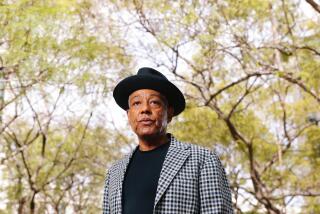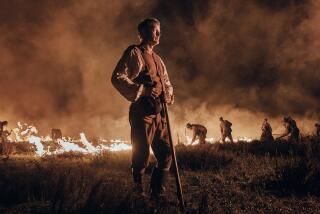‘Promised Land’: Matt Damon, John Krasinski drill Capra ground
The new film “Promised Land,” written by and starring Matt Damon and John Krasinski (the pair also produce with Chris Moore), uses the hot-button issue of fracking — a method of natural gas extraction that utilizes a high-pressure mixture of water and chemicals to break up underground rocks and release the gas — as the backdrop against which to explore nothing less than the current state of American identity. Directed by Gus Van Sant, the film drills down to the question of how we decide who we are.
“If people want to internalize it as a political issue movie, they are going to and we’re not going to be able to stop them,” said Krasinski. But that’s not how he sees it. “In my head, I always just wanted to do a Frank Capra-esque movie. Capra was a genius at toeing that political line in a way that is representative of how it affects all of us rather than sort of this hard-line activist stance on the issue at hand.
“What we wanted to do is flag the responsibility of each and every one of us with each and every issue,” he said. “The idea is, is there a benefit to doing what we’re doing and at what cost? Is it worth it?”
VIDEO: Trailers to upcoming films
Damon echoes the sentiment: “If the movie takes any position, it’s don’t let big money make big decisions for you. You have to make a decision one way or the other, no matter what it is.”
Damon plays an energy conglomerate operative who arrives in a rural Pennsylvania town with a co-worker (a crackling Frances McDormand) to buy up rights for natural gas drilling. As the film progresses, he comes to question whether what he is doing is right either for himself or the community, whether he is the villain of the story (“I’m not a bad guy,” he says often in the film). Krasinski plays an environmental activist who shows up to counter the plan, while Rosemarie DeWitt is a local teacher who finds herself drawn to both the outsiders.
When the film opens in limited release on Dec. 28, it will reach theaters just two years after Krasinski, who Damon credits as “the engine” behind the project, had his initial inspiration. Krasinski first worked with writer Dave Eggers, co-writer of Krasinski’s 2009 film “Away We Go” and who receives story credit on “Promised Land,” before taking the idea to Damon. The two met when Krasinski’s wife, actress Emily Blunt, appeared in “The Adjustment Bureau” with Damon.
CRITIC’S PICKS: Awards race 2013
The story was initially set against the energy issue of wind farming, based around tales of wind turbines that were built for tax subsidies but never became operational. When they discovered in their research that those stories were not as widespread as they initially believed, Damon and Krasinski nearly abandoned the project. But turning their attention to natural gas, they were able to retrofit their characters, structure and theme to fit that issue.
After deciding he wouldn’t have enough preparation time to direct the project as he had initially planned, Damon emailed the script to Van Sant in December just as his flight was departing. By the time Damon landed a few hours later, Van Sant had agreed to direct.
As Damon noted, “I’m a producer on the movie too, so as a producer I can say the best thing that happened for this movie was me stepping down because then we got Gus.”
FULL COVERAGE: Holiday movie sneaks
Van Sant, who had previously been unaware of the controversy over natural gas drilling, said he responded to the human drama in Damon and Krasinski’s script. Rather than the austerity of his films such as “Last Days” or “Elephant” or even the lyricism of the more recent “Milk” and “Restless,” he decided to shoot the film, budgeted at about $18 million, in a straightforward, somewhat classical style.
“I just wanted to stay out of the way,” said Van Sant, likening the style to how he shot “Good Will Hunting.” “I wanted the story to tell itself.”
PHOTOS AND MORE
VIDEO: The making of ‘Argo,’ ‘Les Miz’ and more
VIDEO: Holiday movies - A video guide
PHOTOS: NC-17 movies: Ratings explained
More to Read
Only good movies
Get the Indie Focus newsletter, Mark Olsen's weekly guide to the world of cinema.
You may occasionally receive promotional content from the Los Angeles Times.










